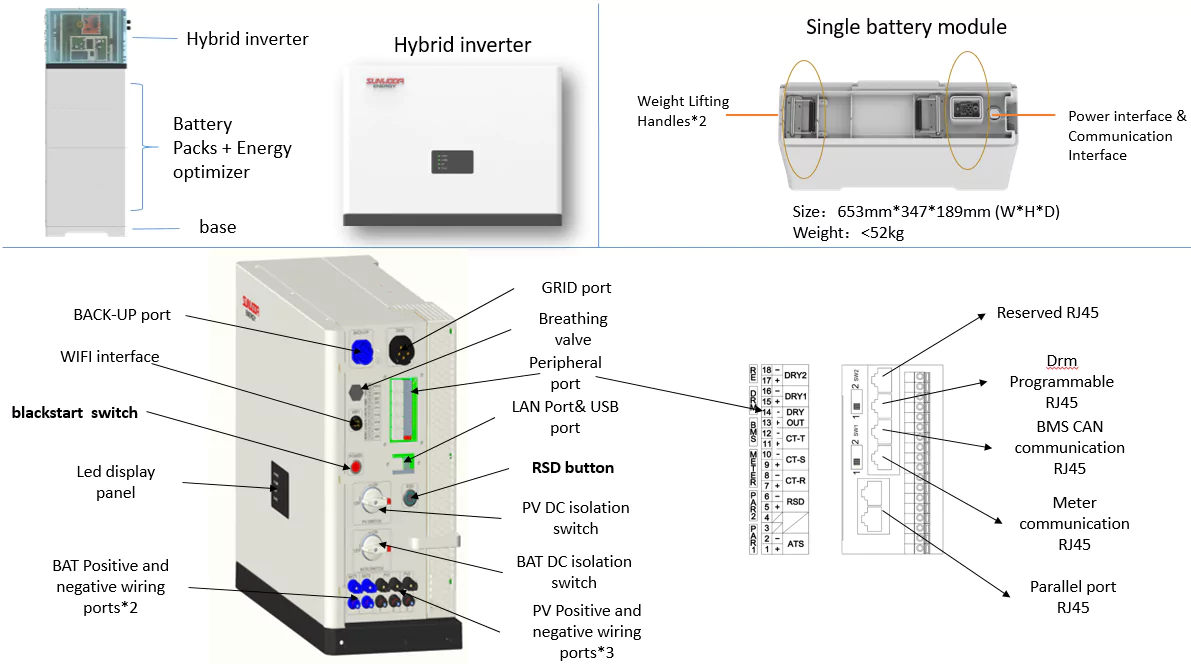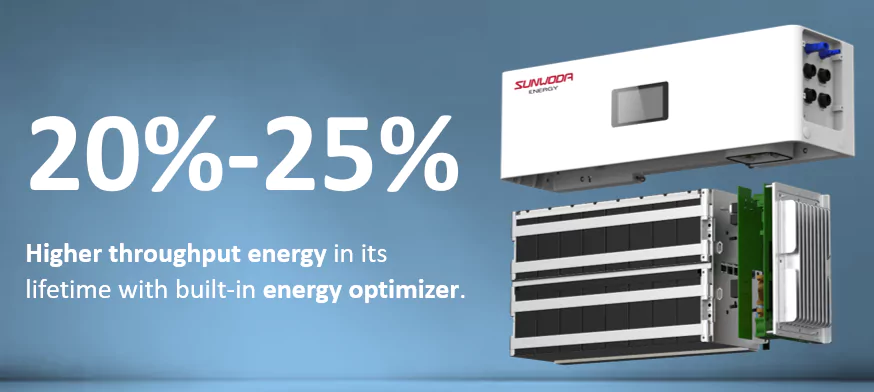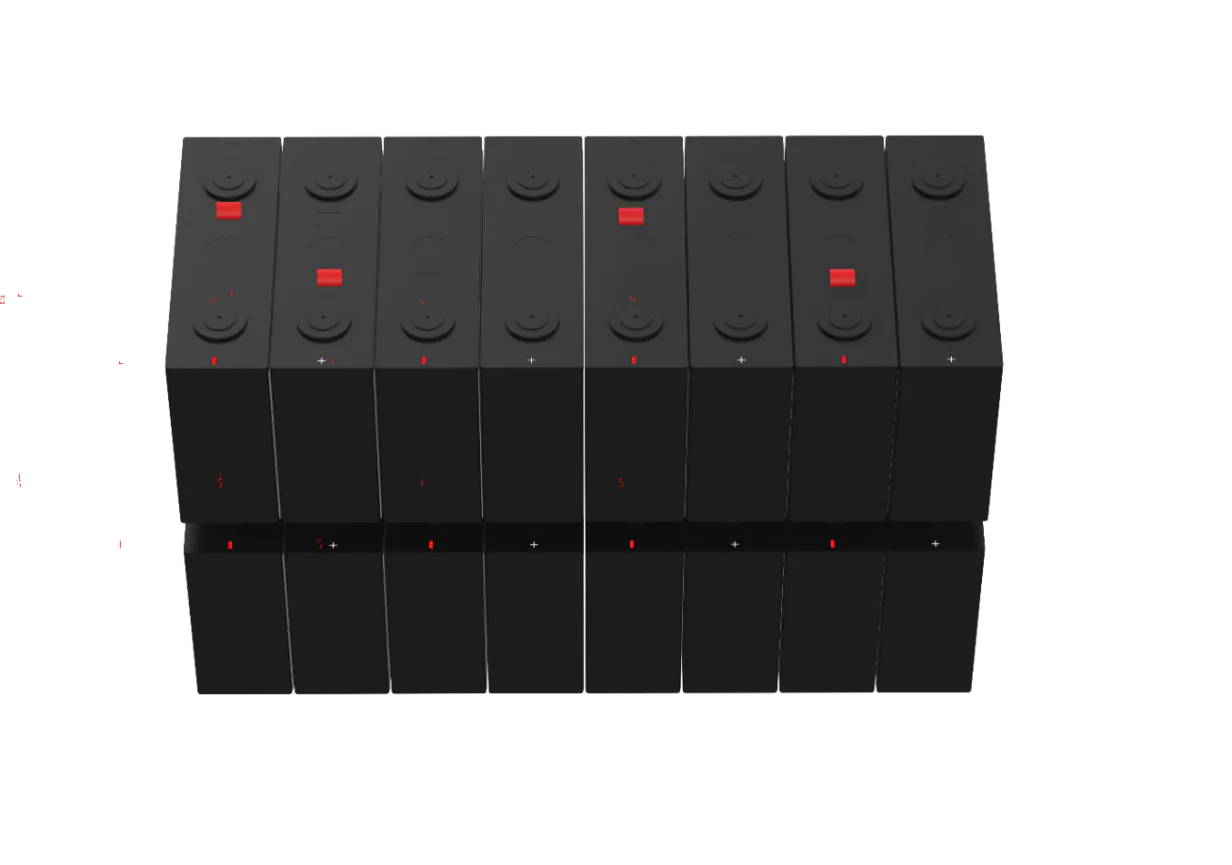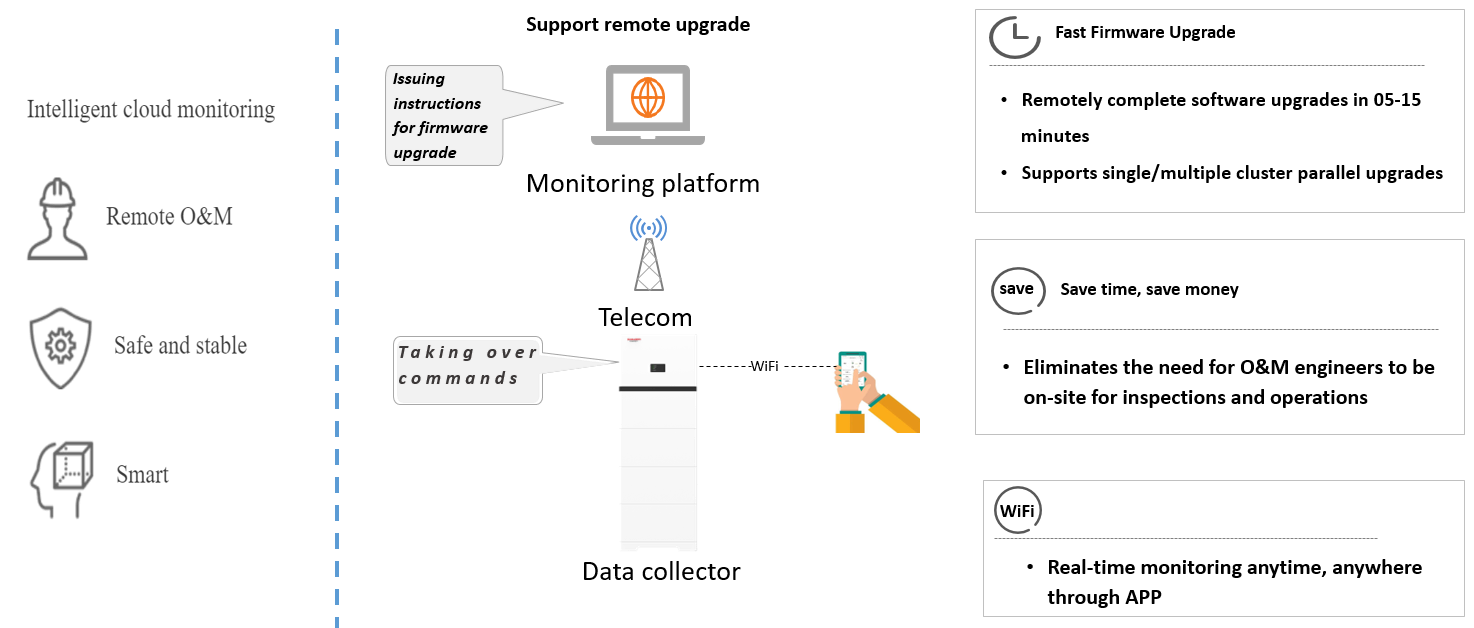Author: MUHAMMAD IBRAR YOUNAS / SUNWODA TEAM

1. Introduction
The SunESS Power is a cutting-edge all-in-one energy storage solution, incorporating a hybrid inverter (ranging from 5kW to 60kW) and modular batteries (spanning from 5kWh to 160kWh). Designed for both residential and small commercial applications, SunESS Power boasts market-leading energy density (105 Wh/dm3) and power density (192.3 W/dm3), enabling efficient use of space with a compact footprint. Its robust IP65 rating allows for reliable performance in both indoor and outdoor environments. The system features a built-in energy optimizer (DC/DC booster) that boosts voltage from 51.2V to 350V-450V, allowing the seamless integration of both new and existing battery modules. This flexibility, coupled with intelligent terminals that eliminate the need for additional wiring, makes SunESS Power a versatile and user-friendly energy solution.
2. System Overview

3. Energy Storage
3.1. Reliable & Long Cycle Life Cells
Sunwoda Energy producing its own premium-grade battery cells. This self-manufacturing capability empowers us to uphold top-tier quality standards and exercise effective control over our products, ensuring that we deliver the best Quality and safest solutions to our customer.
Top quality self-developed cells passed all tests and certifications provides best performance and peace of mind. At 90% depth of discharge, the LiFePO4 battery modules can deliver an impressive 6000 cycles over their lifetime depending on the storage capacity. This extended cycle life translates into years of reliable service.

3.2. SunESS Power overview
The SunESS Power uses lithium iron phosphate (LiFePO4) batteries which are known for their safety, high power density, and long cycle life compared to other li-ion chemistries. The system output rated voltage is 400V, single battery module energy 5kWh, rated power 2.5kW, and supports the modular installation.

● A single energy storage system consists of a Hybrid inverter and multiple battery modules and supports up to four battery modules in parallel in one cluster.
● Single battery module is equipped with DCDC booster/ energy optimizer, which can increase 42~58V module voltage output to 350~450V.
● The system supports up to 2 battery clusters connected in parallel, and the energy can be expanded up to 40kWh with one inverter.
● Supports mixed use of old and new batteries.
● Battery Management System (BMS) provides data acquisition, status monitoring, and control to ensure safe and reliable operation of the system.
● It adopts IP65 protection design and supports outdoor use.

3.3. Modular Design
The battery storage comes in a modular design with 5kWh packs that can be stacked up to 4 units to reach 20kWh of capacity and two clusters(2*20kWh) can be connected in parallel with one inverter. 4 inverters can be connected in parallel. This scalable approach allows tailoring storage to match energy needs and future expansion requirements.

3.4. Battery Management
The battery modules integrate sophisticated battery management to protect against faults, monitor state-of-charge, balance cell voltages, and control charge/discharge for optimal performance and safety. It mainly monitors vital operational parameters such as voltages, currents, and the internal temperature of a battery during charging and discharging. If any parameters exceed the limits, the integrated circuits will sense the exceeded parameter and will apply the protection.

3.5. Intelligent Terminals with highest safety
SunESS Power's advanced design includes intelligent terminals that eliminate the need for complex wiring. These smart terminals simplify the installation process by enabling plug-and-play connectivity, ensuring that each module seamlessly integrates with the system. This feature not only reduces installation time and potential errors but also enhances the overall reliability and efficiency of the energy storage system. With intelligent terminals, setting up and expanding your SunESS Power system becomes straightforward and hassle-free.

3.6. Outer structure material and strength
SunESS Power utilizes an aluminum alloy structure, offering 35% greater cooling and heat dissipation capabilities. The use of galvanized steel and zinc-nickel plated screws, combined with spray painting, ensures superior corrosion resistance. This robust construction provides enhanced safety and protection, making it highly suitable for harsh environmental conditions.

3.7. Ultra-thin/slim and Sleek design

3.8. High Voltage battery packs with built-in energy optimizer

3.9. Cell & Module Balancing for Longer Battery Life
To ensure the battery maintains its rated capacity over thousands of cycles, the SunESS Power employs advanced multi-level battery balancing algorithms:
Cell-Level Passive Balancing: During charge/discharge cycles, the battery management system passively equalizes the state-of-charge across individual cell groups within each 5kWh module through controlled shunting. This prevents cell drift and capacity loss.

Module-Level Active Balancing: The battery control actively equalizes the state-of-charge levels across all paralleled 5kWh battery modules connected to it through dynamic current adjustments. Fully charged/depleted modules are isolated to balance the system.
This comprehensive multi-level balancing regime extracts maximum usable capacity from the battery storage over its lifetime while ensuring consistent performance.
3.10. Mixing New/Old Batteries
A key advantage is the ability to combine new and old battery modules on the same system. Batteries with different SOC and SOH levels can be used together while extracting the full capacity.
Let me explain with an example how the SunESS Power's module-level active balancing and integrated DC/DC architecture allows mixing old and new batteries while extracting full capacity, something not possible with traditional series-string configurations:
Traditional Series Battery String Limitation
In a conventional series-connected battery string, all modules are voltage-summed, so their state-of-charge (SOC) levels must remain balanced during charging and discharging cycles.
Let's take an example of a 10kWh battery bank made up of two 5kWh modules in series. If one of those 5kWh modules are older with reduced capacity, say 3kWh due to degradation, the entire 10kWh battery bank is restricted and can only operate at 6kWh capacity (1 x 3kWh + 1 x 3kWh).
This is because the older 3kWh modules hit their voltage cut-offs sooner than the new 5kWh modules during discharge. The battery management system (BMS) disconnects the full string once any one module reaches its minimum voltage threshold to prevent over-discharging and damage.
Similarly, during charging, the BMS disconnects the string once the first module hits its maximum voltage limit, leaving the others undercharged.
So in a series configuration, the usable capacity equals the capacity of the most degraded module multiplied by the number of modules. The new batteries' extra capacity goes unutilized.
The SunESS Power Solution
Now let's look at the SunESS Power's parallel battery module architecture along with its module-level active balancing:
1) Each 5kWh battery module contains its own integrated DC/DC converter that boosts its 51.2V output to a high voltage 400V.
2) These 400V modules are parallel-connected, not series-summed, to create the overall battery storage capacity.
3) During charging/discharging, the BMS actively monitors and equalizes the state-of-charge across all parallel-connected 5kWh modules.
4) Fully charged or depleted modules are dynamically bypassed, allowing other modules to keep charging/discharging until their SOC levels are balanced.
With this architecture, let's say we integrate a new 5kWh battery modules rated at 100% capacity with the older 5kWh module at 70% capacity (3.5kWh) into an 8.5kWh SunESS Power system:
• During discharge, the 5kWh new module can deplete down to their 5kWh usable capacity while the 3.5kWh old module hit their cut-off at 3.5kWh usable.
• The BMS simply bypasses the old modules once depleted while allowing the new modules to discharge their full remaining capacity.
• In total, 8.5kWh is extracted from the 8.5kWh system (5kWh from new modules + 3.5kWh from old modules).
• Similarly, during charging, the new modules get fully recharged to 5kWh while the old modules are recharged to their 3.5kWh maximum capacity level.
Unlike the series string example, the advanced module-level balancing ensures zero capacity is wasted from the new batteries when intermixed with old packs in the SunESS Power system.

The built-in optimizer independently manages each battery module. When a certain pack is aged or limited, others still work at their best, generating maximum energy. The usable energy can be increased by more than 20%-25% in the lifecycle.

This flexible 'mix-and-match' capability provides a huge advantage. System owners can keep recycling and redeploying older battery modules as new capacity is added incrementally. The maximum usable energy is always extracted from the system over its lifecycle, optimizing the return on investment.
3.11. No Calibration Needed
With a built-in energy optimizer inside each battery module, no calibration is required. To add a new battery module to your existing system, simply install it. After one charge or discharge cycle, the new module's state of charge (SOC) will automatically synchronize with the existing modules, demonstrating the system's simple and efficient management.
3.12. Monitoring sensors
SunESS Power takes battery monitoring to the next level with its comprehensive array of sensors. The system includes eight independent temperature sensors, each monitoring two cells. This configuration allows for precise temperature monitoring, ensuring each cell operates within safe limits. Additionally, 16 voltage sensors are employed to monitor the voltage of each individual cell, providing detailed insights into the battery's health and performance. This meticulous monitoring enhances safety, reliability, and overall system efficiency.

3.13. Temperature Flexibility and Heating
Unlike most Lithium batteries on the market, which can suffer from severely reduced charge rates and even shutdown at temperatures below freezing, the SunESS power batteries contain a thermal management system that enables the battery to charge/discharge at very low temperatures. It achieves this through a small 2*80W heating elements, which preheats the cells and improves low-temperature charging performance. This uses a small amount of energy but only activates the preheating function for short durations before charging/discharging.
The SunESS Power system is designed to operate reliably across an extremely wide temperature range from -10°C to +50°C for charging and -20°C to +50°C for discharging.


3.14. Auto Isolation of faulty modules

3.15. Market leading energy/power density
With market-leading energy and power density, this system achieves remarkable metrics, boasting a maximum energy density of 105Wh/dm3 and a maximum power density of 192.3 W/dm3. Thanks to its compact size and high energy and power density, it occupies minimal footprint, offering unparalleled flexibility in installation. Whether it's a residential, small commercial setting, this system can be seamlessly integrated into any space, delivering superior performance without compromising on space.


3.16. Black Start Capability of SunESS Power
SunESS Power is equipped with a black start function, which ensures resilience and reliability even in challenging conditions. If the battery shuts down due to a prolonged power outage or lack of PV generation during cloudy weather, the black start capability allows the system to automatically power back on as soon as it receives any power from the grid or PV panels. This feature ensures continuous operation and quick recovery from outages, providing peace of mind and uninterrupted energy availability.
4. Hybrid inverter Features
4.1. Product Features- Operating modes

4.2. Operating Modes

4.3. Seamless Transition
The intelligent controls allow a seamless transition between grid-tied and off-grid modes, ensuring uninterrupted power delivery to connected loads even when switching operation modes.

4.4. Diesel/gas Generator/heat pump integration
In off-grid mode, the SunESS Power's inverter output can seamlessly parallel and sync with other distributed energy sources like diesel generators or heat pumps. After a power grid outage occurs, the generator starts up. The energy storage system switches to the generator contacts through the ATS device, connecting the generator to the energy storage system.
This hybrid integration provides the flexibility to supplement the solar-plus-storage system with dispatch able generator capacity during periods of high load demand or low renewable generation. The generators can co-power critical loads alongside the SunESS Power's battery output.

4.5. 3-Phase Unbalanced Loads
Most battery energy storage systems require balanced 3-phase loads for stable operation. However, the SunESS Power inverters can efficiently handle unbalanced loads across their 3-phase output.
This flexibility allows powering a wide range of unevenly distributed 3-phase loads seamlessly without tripping off. It makes the system suitable for residential and light commercial applications.
5. Easy Installation and Commissioning
One of the major advantages of the SunESS Power system is its sleek, modular all-in-one design that simplifies installation and provides versatility across diverse applications.
For installers, the integrated construction means fewer components to handle on site. The inverter and battery units simply need to be mounted and the intelligent terminals are used for power and communication. This plug-and-play approach streamlines deployment compared to assembling separate inverter and battery products.


5.1. IP65 Protection

5.2. Monitoring
The SunESS Power supports integration of energy meters and current transformers (CTs) to precisely monitor energy flows within the home or business. This visibility is crucial for intelligent load optimization.
5.3. User friendly APP
An intuitive mobile application (Solarman smart) provides insights into solar production, storage levels, and load consumption data. Users can define operating modes and preferences through this app.
For All installers, just few clicks are necessary to finish the installation and start your commissioning with your fingertips.

5.4. Remote Access
Communication via Wi-Fi, 4G cellular, RS485 or CAN enables remote monitoring and control of the system from anywhere using the software app or other monitoring platforms.

6. Application scenarios
The system's modular battery storage with capacities from 5kWh to 160kWh accommodates energy needs for different application scenarios:
No matter the use case, the SunESS Power provides a right-sized, reliable and safe energy storage solution.

7. Robust Safety Protections
User safety is a paramount focus through hardened system protections at every level:

AFCI Arc-Fault Protection: The inverter integrates AFCI protection function to detect photovoltaic panel parameters in real time. When there is abnormal arcing caused by poor contact of the photovoltaic panel occurs, the inverter switches to standby mode within 2.5 seconds, turns off power, and sends an alarm message. The operation and maintenance personnel are notified in a timely manner to maintain the system and ensure the safety of personnel and property
RSD Rapid Shutdown: An integrated rapid shutdown (RSD) unit allows safely de-energizing the PV and battery DC sides to protect against electrical hazards during maintenance or emergencies.
DC/AC Surge Protection: Type II surge protection devices (SPDs) on both DC and AC terminals safeguard against voltage spikes from lightning or utility grid events.
Insulation Resistance Detection: Continuously monitoring the insulation impedance to ground prevents faults from low resistances on the PV side.
Residual Current Monitoring: Advanced residual current monitoring and protection ensures rapid disconnection in case of ground faults.
Anti-Islanding Protection: Sophisticated anti-islanding prevents the inverter from powering the utility grid during outages to protect personnel.
Dry Contact Scheduling: The system supports dry contact signals from external sources like a backup generator to schedule operation modes.
With these multi-layered safety mechanisms combined with stringent quality controls during manufacturing, the SunESS Power provides a robust, reliable, and code-compliant all in one solution for the safety of users and installers alike.
8. 12-Year System Warranty
Underlining its robust construction and design for longevity, Sunwoda offers an industry-leading 12-year warranty* that covers the complete SunESS Power system – hybrid inverter and batteries. We’re 100% committed to quality, durability, and satisfaction. This unmatched 12-year warranty is just one further example of this commitment.
This comprehensive long-term warranty demonstrates the Sunwoda’s confidence in the robust engineering and stringent quality controls during production. It provides investment security for SunESS power owners by guaranteeing performance over an extended period.
Note*: Please refer to our warranty terms for better understanding.
9. Conclusion
SunESS Power stands out as an all-in-one solution, incorporating a hybrid inverter (ranging from 5kW to 60kW) and modular batteries (ranging from 5kWh to 160kWh). This makes it an ideal product for both residential and small commercial applications. With an exceptionally high energy density of 105 Wh/dm3 and a power density of 192.3 W/dm3, this high-density design allows for a compact footprint, enabling installation in even the most space-constrained environments, while also supporting both indoor and outdoor installations due to its IP65 rating.
A notable feature of SunESS Power is the built-in energy optimizer (DC/DC booster) that boosts the voltage from 51.2V to 350V-450V. This allows the seamless use of both old and new batteries together, as each battery module operates independently. The system incorporates cell-level passive balancing and module-level active balancing, eliminating the need for calibration when adding new batteries.
The hybrid inverter supports up to 1.5 times the PV capacity and integrates easily with diesel generators or heat pumps for off-grid scenarios. With a lightning-fast switching time of less than 10ms from on-grid to off-grid, SunESS Power ensures uninterrupted energy supply. The installation process is streamlined and error-free, thanks to intelligent terminals that eliminate the need for wiring, allowing for a swift 20-minute installation. Commissioning the system is straightforward, requiring only a few clicks on our user-friendly mobile app.
SunESS Power also excels in extreme conditions, operating efficiently below zero temperatures due to built-in heaters in each battery module. As a product of Sunwoda Energy, a company with extensive experience in energy storage systems since 1997, SunESS Power benefits from high-quality LFP cells, BMS, and PCS, all designed and manufactured in-house. This makes it a comprehensive, one-stop solution for customers.
With local support available globally, Sunwoda Energy ensures top-tier service and support, negating the need to engage multiple suppliers for different components. Sunwoda offers a high-quality, reliable, and fully integrated energy storage solution with SunESS Power, demonstrating our commitment to excellence and customer satisfaction.
Learn more about the advantages, application scenarios, and product specifications of SunESS Power: https://en.sunwodaenergy.com/inverter/all-in-one-residential-ess-suness-power.html
